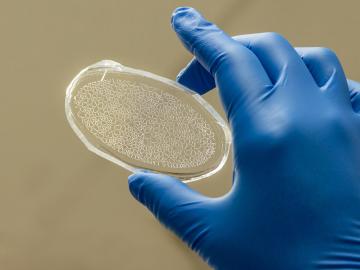
Filter News
Area of Research
- (-) Biology and Environment (67)
- (-) Supercomputing (81)
- Advanced Manufacturing (22)
- Biological Systems (2)
- Building Technologies (1)
- Computer Science (5)
- Electricity and Smart Grid (3)
- Energy Science (194)
- Energy Sciences (1)
- Functional Materials for Energy (2)
- Fusion and Fission (11)
- Fusion Energy (3)
- Isotope Development and Production (1)
- Isotopes (5)
- Materials (118)
- Materials Characterization (1)
- Materials for Computing (19)
- Materials Under Extremes (1)
- National Security (30)
- Neutron Science (42)
- Nuclear Science and Technology (12)
- Quantum information Science (3)
- Sensors and Controls (1)
- Transportation Systems (1)
News Topics
- (-) 3-D Printing/Advanced Manufacturing (13)
- (-) Bioenergy (50)
- (-) Cybersecurity (9)
- (-) Energy Storage (11)
- (-) Exascale Computing (28)
- (-) Frontier (32)
- (-) Grid (7)
- (-) Materials Science (22)
- (-) Software (1)
- (-) Space Exploration (3)
- Advanced Reactors (2)
- Artificial Intelligence (41)
- Big Data (29)
- Biology (76)
- Biomedical (28)
- Biotechnology (15)
- Buildings (6)
- Chemical Sciences (15)
- Clean Water (11)
- Composites (5)
- Computer Science (105)
- Coronavirus (22)
- Critical Materials (4)
- Environment (105)
- Fusion (2)
- High-Performance Computing (56)
- Hydropower (8)
- Isotopes (3)
- Machine Learning (20)
- Materials (24)
- Mathematics (5)
- Mercury (7)
- Microscopy (16)
- Molten Salt (1)
- Nanotechnology (16)
- National Security (9)
- Neutron Science (16)
- Nuclear Energy (5)
- Partnerships (6)
- Physics (9)
- Polymers (4)
- Quantum Computing (20)
- Quantum Science (25)
- Security (6)
- Simulation (26)
- Summit (47)
- Transportation (8)
Media Contacts

Scientists at ORNL have created a miniaturized environment to study the ecosystem around poplar tree roots for insights into plant health and soil carbon sequestration.

Chemical and environmental engineer Samarthya Bhagia is focused on achieving carbon neutrality and a circular economy by designing new plant-based materials for a range of applications from energy storage devices and sensors to environmentally friendly bioplastics.
Scientists at Oak Ridge National Laboratory are closer to unlocking the secrets to better soil carbon sequestration by studying the tiny, sand-like silicon deposits called phytoliths in plants.

Doug Kothe has been named associate laboratory director for the Computing and Computational Sciences Directorate at ORNL, effective June 6.

To optimize biomaterials for reliable, cost-effective paper production, building construction, and biofuel development, researchers often study the structure of plant cells using techniques such as freezing plant samples or placing them in a vacuum.

The Frontier supercomputer at the Department of Energy’s Oak Ridge National Laboratory earned the top ranking today as the world’s fastest on the 59th TOP500 list, with 1.1 exaflops of performance. The system is the first to achieve an unprecedented level of computing performance known as exascale, a threshold of a quintillion calculations per second.

ORNL scientists will present new technologies available for licensing during the annual Technology Innovation Showcase. The event is 9 a.m. to 3 p.m. Thursday, June 16, at the Manufacturing Demonstration Facility at ORNL’s Hardin Valley campus.

A study led by researchers at ORNL could help make materials design as customizable as point-and-click.

Tackling the climate crisis and achieving an equitable clean energy future are among the biggest challenges of our time.

ORNL scientists had a problem mapping the genomes of bacteria to better understand the origins of their physical traits and improve their function for bioenergy production.


